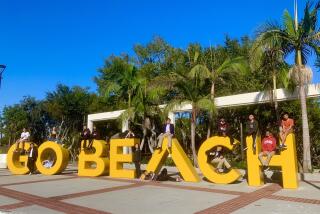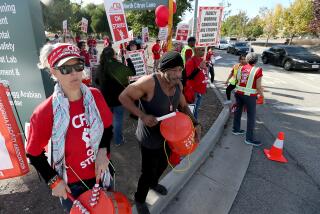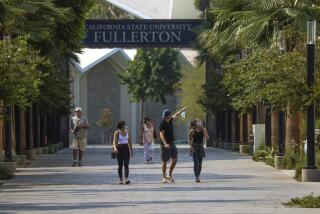Cal State trustees seek funds to fix aging campus buildings
The abrupt rattle and jolt was so disconcerting that Kelly Shaw decided never again to use the elevator to get to her geology classes in McCarthy Hall on the Cal State Fullerton campus.
But the escalator in the 50-year-old, six-story natural sciences and math building presents its own challenges: It is prone to breaking down and replacement parts are hard to locate.
At certain times of the day, Shaw said, hundreds of students wait in a line that stretches outside the building to get on the escalator, which goes only as high as the fourth floor. Students and faculty must take the stairs to upper floors to reach many of the classrooms.
A temperamental escalator, water damaged buildings and other maintenance issues are the result of years without a budget to repair or replace aging systems.
Campus officials throughout the 23-school system have operated in a “patch-and-fix-it” mode for years. As a result, the deferred maintenance bill tops more than $1.7 billion — the result of old age hitting up against the state’s budget crisis. Campus leaders deciding where to make cuts have prioritized student services at the expense of repairs, officials said.
Electrical main frames, cooling systems and sewer pipes aren’t the sexiest topic, but the issue took on significance recently when Gov. Jerry Brown suggested that the Cal State Board of Trustees might fix its buildings before seeking money to increase enrollment.
“It sounds like the buildings have to be taken care of before you bring in more students,” Brown told the board last week.
The trustees’ proposed 2014-15 budget plan seeks an additional $250 million from the state, including $75 million to increase student enrollment and an initial $15 million to help finance up to $800 million in bonds for maintenance needs.
But Brown warned the board that convincing the Legislature might be difficult.
Officials requested $50 million for maintenance in the last budget but didn’t get anything, said Elvyra San Juan, assistant vice chancellor for capital planning, design and construction.
“We’ve tried to have a balanced approach, but with the budget reductions in the last few years, our priority has been to continue to offer class sections,” San Juan said. “However, when a roof is leaking, at a certain point you have to replace the roof. The campuses manage on a case-by-case basis as best they can. But emergency repairs cost us more.”
The backlog of repairs poses a huge obstacle for a system feeling pressure to increase enrollment, that in turn could add to maintenance needs.
A recital hall at Humboldt State recently reopened after being closed for a month because of a crack in the aging structure. Classes and recitals had to be rescheduled and relocated.
The Cal State Fresno campus was without power for four days beginning last New Year’s Eve, after the main switch failed. But the 1960-vintage replacement part couldn’t be found locally; it was finally located at a shop in Dallas and flown into LAX on New Year’s Day, said Robert Boyd, associate vice president for facilities management.
The campus opened its emergency operations center during the crisis and used portable generators and manual systems to save research projects, feed and care for farm animals, and cool storage units holding cadavers.
Boyd estimated the campus has received about $500,000 in each of the last few years to address about $150 million of needed repairs.
“I’ve been at the university for over 30 years and this time we haven’t been able to keep pace,” Boyd said. “We’re like a city, serving 22,000 students on 388 acres. Cable and other equipment normally has a life span of 25 years and we’re pushing 60.”
The backlog of repairs at the Fullerton campus is also an estimated $150 million in costs, said Jay Bond, associate vice president for facilities planning and management and campus architect.
“Do we admit more students or maintain more buildings?” he said. “It seems to me like a balanced approach is the way to go. Have we gotten out of balance? Maybe we have and it’s time to tip the scales a bit.”
University Hall, also on the campus, was built in the 1990s but the stucco and wood structure has already had to be encased in silicon to keep out water that gets trapped behind walls. During winter rains, faculty and staff in many offices have to use buckets to catch the drips.
Meanwhile, the erratic escalator is not McCarthy Hall’s only frustration, said David Bowman, a professor of geophysics who has worked there for years. Aging technology and other issues, such as inoperable exhaust hoods for lab experiments, have caused problems.
“Science has evolved in the last 50 or 60 years and the technology requirements have evolved but we don’t have the ability to keep pace because of deferred maintenance,” Bowman said. “It’s absolutely hindering our ability to do work.”
Just because McCarthy Hall is the oldest building on campus, Shaw said, doesn’t mean it has outlived its usefulness.
“OK, we’re geologists,” she said. “We deal with the oldest stuff.”
More to Read
Start your day right
Sign up for Essential California for news, features and recommendations from the L.A. Times and beyond in your inbox six days a week.
You may occasionally receive promotional content from the Los Angeles Times.







